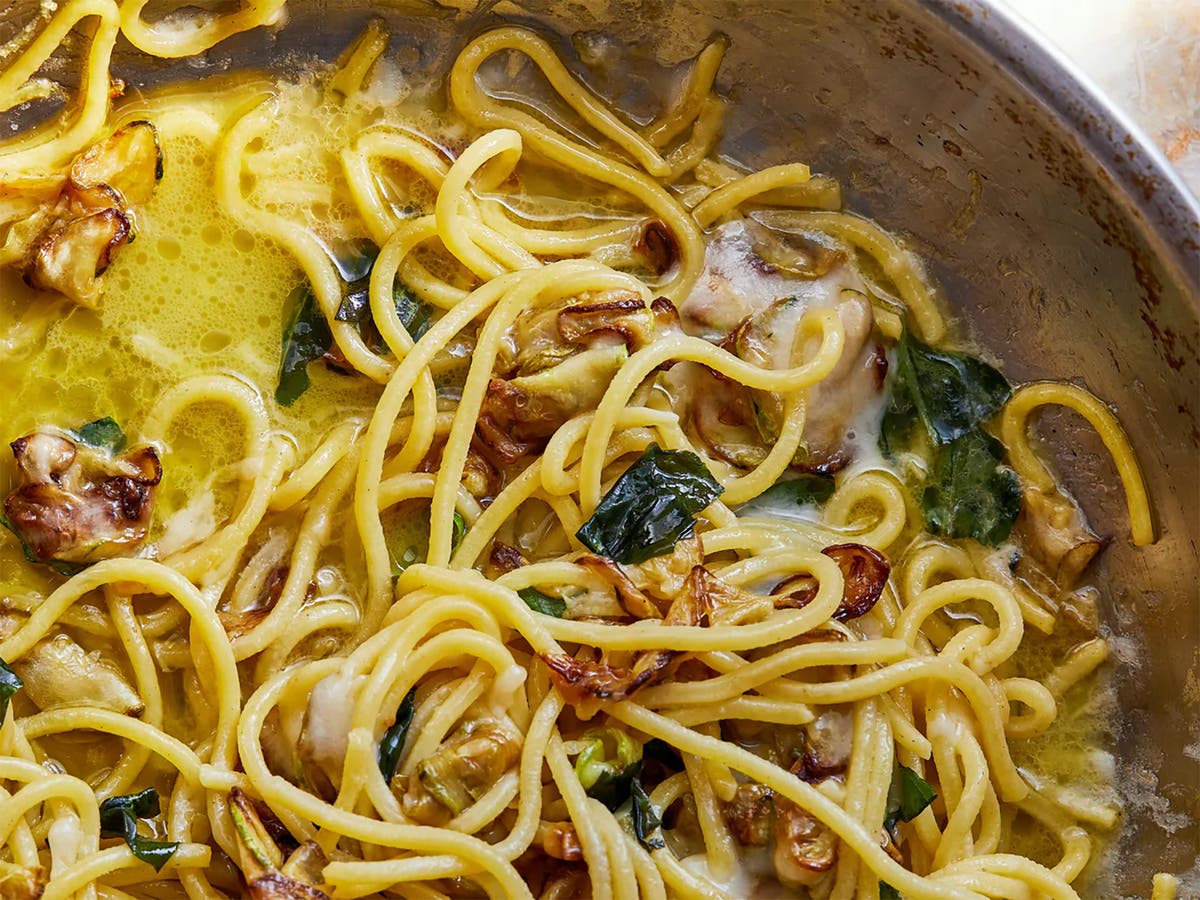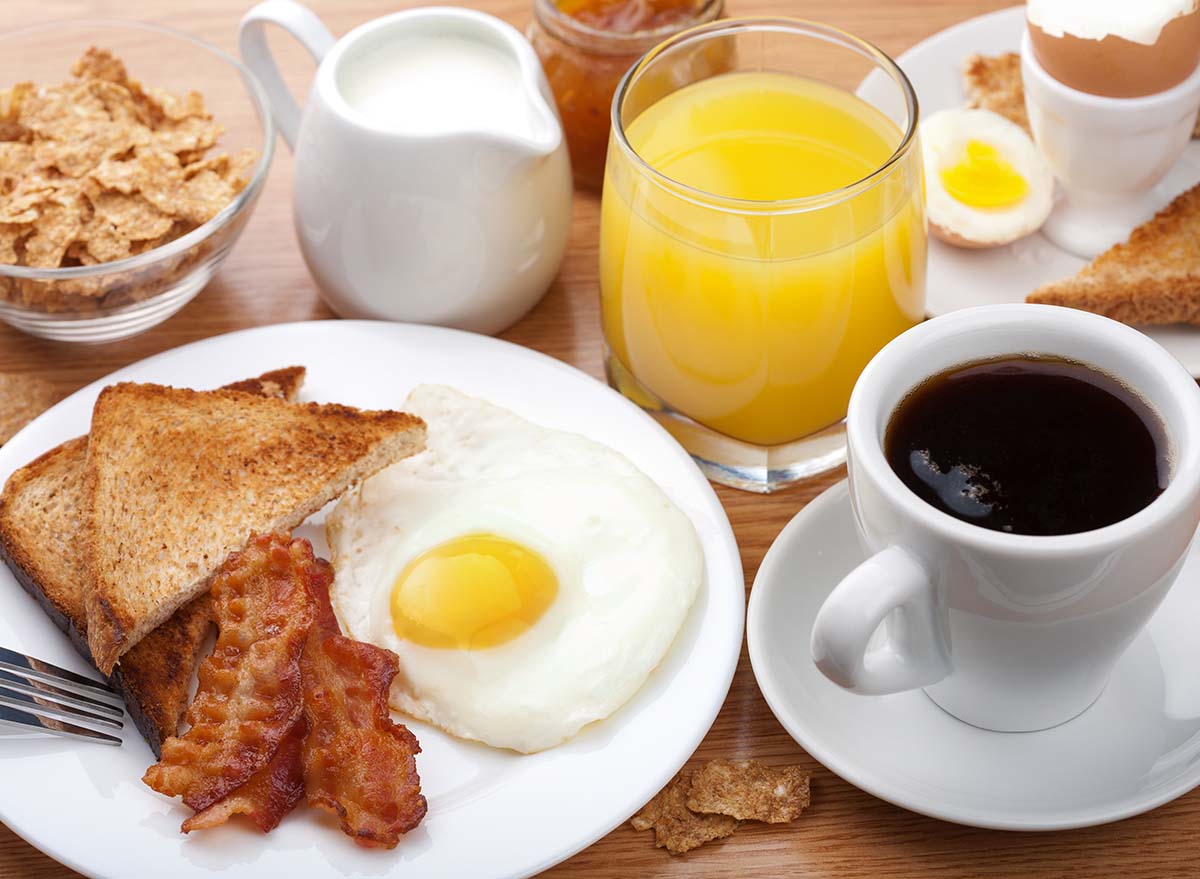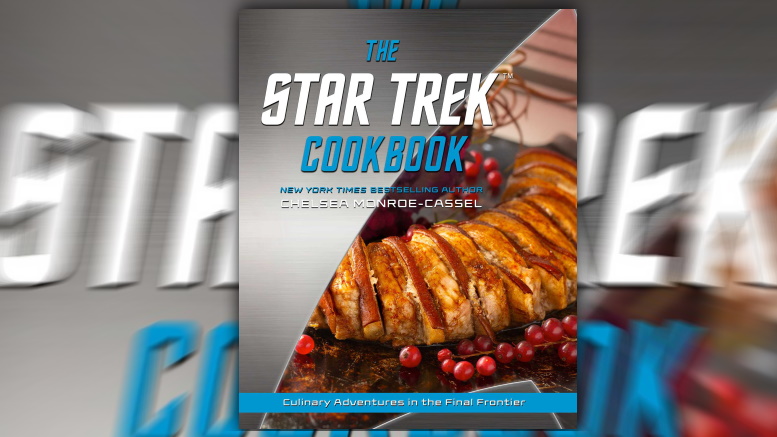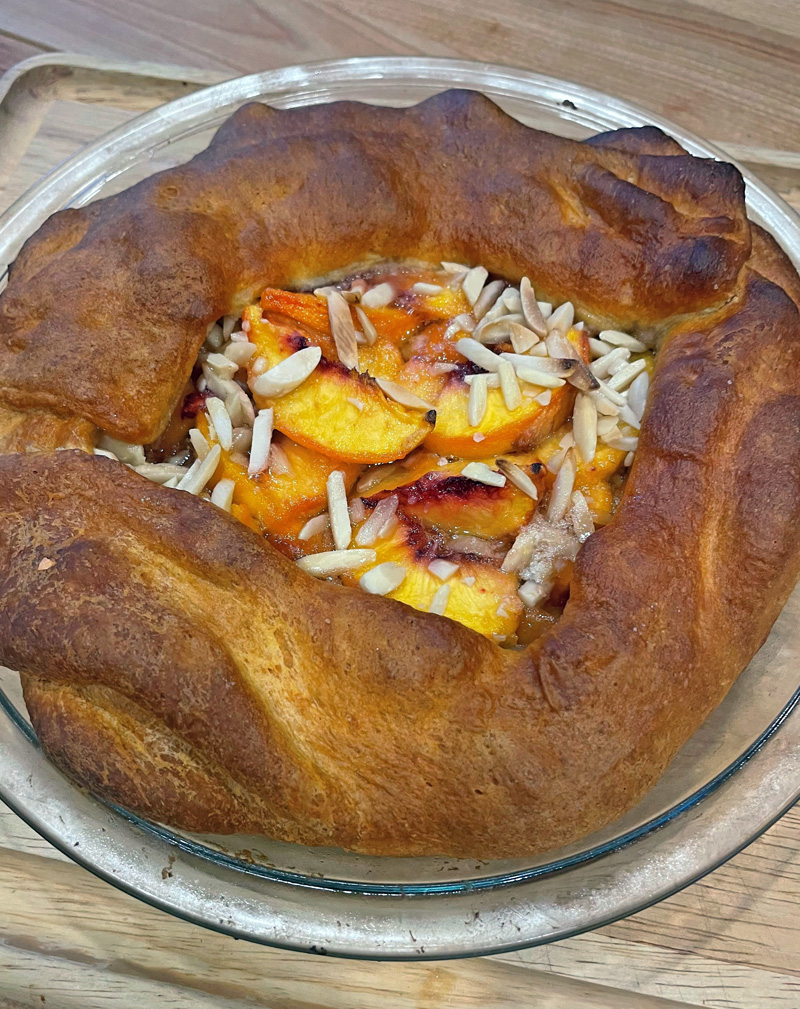If you’ve seen Stanley Tucci’s Looking for Italy collection, you may’ve caught the person himself waxing lyrical a few seemingly humble dish of spaghetti with courgettes – or zucchini to the Italians. In a picture-postcard scene, Stanley samples the dish at a cliffside restaurant with views of the ocean, earlier than confidently claiming it’s “probably the greatest issues he’s ever eaten”. The dish in query? That’d be spaghetti alla Nerano.
Spaghetti alla Nerano is a dish of pasta, fried courgettes and cheese that hails from the southern Italian area of Campania. Extra particularly, the dish’s origins could be traced again to at least one girl and one Campanian village. That girl is Maria Grazia, who created the dish at her namesake restaurant, Mariagrazia, in 1952. Hidden away within the picturesque fishing village of Nerano, on the sun-kissed Amalfi coast, the restaurant (and the recipe) have been handed down the generations – and each are nonetheless going robust at the moment.
The dish itself is a lesson in how you can make easy elements sing; the unique recipe includes little greater than pasta, courgettes, Provolone del Monaco cheese and basil. Provolone del Monaco is a buttery, considerably spicy cow’s milk cheese that’s typical of the Sorrento area, however it’s a lot tougher to seek out than common Provolone within the UK. For those who can’t discover both, a mixture of Pecorino and Parmigiano Reggiano cheese works nicely.
Serves: 4
Prep time: 10 minutes | Cook dinner time: half-hour
Elements:
400g spaghetti
6 medium courgettes (roughly 1kg), sliced into skinny rounds
Handful of recent basil leaves, torn
200g Provolone (or 100g every of Pecorino and Parmigiano Reggiano), grated.
500ml sunflower oil, for frying the courgettes
50g butter
Salt and pepper, to style
Technique:
Warmth the sunflower oil in a big, excessive sided frying pan. You need the oil to be scorching, so take a look at it by dropping in a single disc of courgette and checking if it sizzles.
As soon as the oil is suitably scorching, add your sliced courgettes and deep-fry till golden (you may want to do that in batches relying on the scale of your pan).
Take away your courgette rounds with a slotted spoon and drain on kitchen paper, then put them in a bowl and go away to chill to room temperature.
Subsequent, carry a pan of nicely salted water to the boil and begin cooking your pasta – goal for a few minutes lower than the packet directions.
Whereas the pasta is cooking, put a frying pan on medium and warmth your cooled courgette, stirring often and including a few ladles of pasta water.
As soon as the courgettes begin to soften, add the butter and stir till it melts, breaking the courgettes up with the again of a picket spoon as you go.
As soon as your pasta is al dente, drain it (reserving some extra pasta water) and add to your pan of courgettes, together with many of the cheese.
Take away your pan from the warmth and toss to mix, including extra pasta water when you want (you’re on the lookout for a silky sauce that coats your pasta).
Season to style, then serve sprinkled with extra cheese and a few torn basil leaves.
In search of consolation? Attain for layers
(Pasta Evangelists)
In search of consolation? Attain for layers. Solely at the moment, they’re not within the type of a worn-in jumper or fluffy fleece, however layers of golden fried aubergine, melting mozzarella and clean tomato sauce. Aubergine parmigiana – or parmigiana di melanzane to the Italians – is a real consolation basic, and for good cause.
From only a handful of elements, some light frying and a wholesome hit of Italian cheese, comes a warming dish wealthy in savoury flavour. In distinction to many different consolation meals, aubergine parmigiana can be low-carb (and no much less scrumptious for it). It’s very straightforward to make too, with the one actual effort coming from frying the aubergine slices in batches (an important step, so don’t rush it).
Like many basic Italian dishes, the origins of parmigiana di melanzane are contested. The areas of Campania and Sicily each declare to have birthed it, however we like to think about aubergine parmigiana as a collaborative effort; it was possible that it did first emerge from the island of Sicily, the place Arab colonisers first launched the aubergine to Italy. The dish was then improved on in Naples with the addition of milky mozzarella.
Serves: 4-6
Prep time: 20 minutes | Cook dinner time: 1 hour
Elements:
4 massive aubergines
100ml olive oil, for frying and drizzling
300ml do-it-yourself tomato sauce or shop-bought passata
300g mozzarella (two balls)
150g parmesan, grated
15g recent basil leaves, torn
50g breadcrumbs, recent or dried
Chef’s tip: If you wish to make this dish vegetarian, simply swap out the parmesan for a vegetarian various.
Technique:
Prep and fry the aubergines.
Drain the mozzarella and lower into skinny slices.
Slice the aubergines into 5mm rounds.
In a deep frying pan, warmth two inches of oil till scorching.
Fry your aubergines in batches till golden on either side.
Take away from the pan and drain on a baking tray lined with kitchen roll.
Assemble your parmigiana: in a big rectangular baking dish (pyrex is ideal), make a layer of aubergine slices, overlapping them as you go.
Cowl your aubergine base with a skinny layer of passata, then high with 1 / 4 of the mozzarella, parmesan and basil.
Repeat the layers on this sample (aubergine, sauce, cheese) till you’ve used all of it up, (don’t fear when you finish on a layer of aubergine).
High with a closing dusting of parmesan, a scattering of breadcrumbs and a drizzle of olive oil.
Bake your parmigiana: preheat your oven to 180C (160C fan/fuel mark 4).
As soon as scorching, bake your parmigiana for half-hour, or till golden.
Take away your parmigiana from the oven and go away to relaxation, earlier than serving heat.
Chef’s tip: You probably have time to get forward, your parmigiana will profit from being left to sit down for 4-12 hours after the primary bake. This intensifies the flavours and helps the parmigiana layers to agency up. Whenever you’re able to eat, merely reheat at 180C (160C fan/fuel mark 4) for 10-Quarter-hour, then slide underneath a scorching grill for a couple of minutes till the highest is a riot of golden bubbles.
Spaghetti alla chitarra interprets to ‘guitar spagehtti’
(Pasta Evangelists)
Spaghetti alla chitarra – which interprets to “guitar spaghetti” – is so named as a result of it’s made by pushing a sheet of pasta dough onto a picket pasta cutter lined with guitar-like wire strings. The chitarra cuts the dough into lengthy strands that resemble a thicker, squarer spaghetti – qualities that make this pasta form a really perfect associate for creamy sauces and chunky meat ragú.
Historically made out of a recent flour and water dough, spaghetti alla chitarra is a typical form of the central Italian area of Abruzzo, in addition to its neighbour Lazio (the place it’s as an alternative often known as tonnarelli). In Lazio, you’ll usually discover this form paired with cacio e pepe, however in Abruzzo it’s extra generally served alongside the area’s well-known lamb ragú.
Abruzzo’s rocky, mountainous inside is prime sheep-rearing nation, and you will not go far with out recognizing a flock of hardy sheep roaming the craggy hillsides. It’s no shock then, that the Abruzzese like to eat lamb. Arrosticini – skewers of lamb roasted over an open hearth – are a giant favorite, however this lamb ragú with pink peppers is the world’s signature pasta sauce. The candy peppers lower via the wealthy lamb completely, making a sauce that’s good all yr spherical.
Serves: 4
Prep time: Quarter-hour | Cook dinner time: 2 hours
Elements:
400g spaghetti alla chitarra, recent or dried
400g lamb shoulder, lower into small cubes
2 massive pink peppers, deseeded and lower into skinny strips
3 cloves of garlic, thinly sliced
1 tin of peeled plum tomatoes
500ml lamb or hen inventory
125ml dry white wine
2 tbsp olive oil
3 bay leaves
Salt and pepper, to style
50g grated pecorino, to complete
Technique:
Put a big saucepan over a medium warmth and add the olive oil. As soon as scorching, add the lamb and fry till evenly browned.
Add the garlic, bay leaves and a pinch of salt, then fry till the garlic is golden (watch out to not let it burn). Pour within the wine and let it cut back by about half.
Add the tomatoes and pink peppers, breaking the tomatoes up with the again of a spoon. Pour in half of the inventory, stir and convey to a simmer.
Cowl and cut back the warmth to low, then let every thing bubble away for 1½ – 2 hours, till the lamb is tender. Add extra inventory if it begins to look dry.
Boil a big pan of water. Salt nicely, add the pasta, stir, then cook dinner till al dente (3-4 minutes for recent, 2 minutes lower than the packet directions for dried).
Drain the pasta, reserving some cooking water. Switch the pasta to your pan of ragú and toss till nicely coated, including a splash of pasta water to loosen.
Divide between bowls, season with salt and pepper and high with a beneficiant handful of pecorino. Buon appetito!
Pasta alla gricia is one in every of Rome’s most quintessential pasta dishes
(Pasta Evangelists)
Pasta alla gricia is one in every of Rome’s most quintessential pasta dishes. Combining guanciale (cured pork cheek), pecorino romano cheese, black pepper and a graceful of pasta water right into a silky sauce, pasta alla gricia packs a wealthy, porky punch regardless of its deceptively easy elements record.
Guanciale is the center and soul of this dish. Throughout Rome, salumerie counters are piled excessive with thick slabs of this fat-marbled marvel, which is made out of salt-cured pig cheek. Fattier than its well-known cousin, pancetta, guanciale releases this deeply flavoured fats when fried – enriching pasta alla gricia with its significantly savoury flavour.
Though it’s much less well-known than the three different basic Roman pastas: carbonara, amatriciana and cacio e pepe, pasta alla gricia has truly been round for lots longer. Certainly, pasta alla gricia is often regarded as the muse on which these dishes had been constructed (add egg and you’ve got a carbonara, add tomatoes and you’ve got amatriciana).
As a dish that depends on only a few elements, utilizing the very best quality you possibly can lay your arms on is essential – for Romans, it’s not pasta alla gricia except you employ guanciale and pecorino romano. Relating to choosing the right pasta form, we’d lean in direction of the sauce-catching ridges of rigatoni, however spaghetti can be a standard pairing in Rome’s trattorie.
Serves: 4
Prep time: 5 minutes | Cook dinner time: Quarter-hour
Elements:
400g rigatoni (spaghetti, bucatini or penne would additionally work nicely)
250g guanciale, lower into skinny batons
120g pecorino romano, grated
2 tbsp olive oil
Salt and freshly floor black pepper, to style
Chef’s tip: For those who’re struggling to seek out guanciale, exchange it with the identical quantity of excellent high quality, unsmoked pancetta – we promise to not inform any Romans.
Technique:
Deliver a big pan of water to the boil, salt generously, add the pasta, stir, then cook dinner till al dente (sometimes 2 minutes lower than the packet directions).
Whereas the pasta cooks, add the oil and guanciale to a big frying pan and placed on a medium warmth.
Fry gently, till the fats has rendered and the guanciale items are beginning to flip golden.
Add a ladle of your pasta water to the pan of guanciale, flip the warmth down and let it bubble away till the pasta is prepared.
As soon as the pasta is prepared, drain, reserving a number of the pasta water. Add the pasta to the frying pan together with two-thirds of the cheese and toss nicely.
Proceed including splashes of the reserved pasta water and tossing every thing collectively till you have got a shiny sauce.
Take away from the warmth, high with the remaining cheese and a wholesome grind of black pepper, then serve instantly. Buon appetito!
In Puglia, one pasta form dominates
(Pasta Evangelists)
In Puglia, the sun-soaked heel of Italy’s boot, one pasta form dominates. Named after the ‘little ears’ that every form is claimed to resemble, orecchiette (pronounced oh-reck-ee-ET-tay) are a primary instance of the area’s easy, rustic delicacies. From a vegan pasta dough of flour, water and salt, Pugliese nonne have been hand-rolling orecchiette because the twelfth century. Even at the moment, within the cobbled previous city of the area’s capital, Bari, girls craft orecchiette on tables alongside la strada delle orecchiette (an unofficial, however becoming moniker).
Puglia’s basic and most genuine orecchiette dish is orecchiette con cime di rapa – which sees the form paired with a sauce of garlic, anchovies and cime di rapa. Recognized within the UK as turnip tops or rapini, cime di rapa has a mustardy, slightly-bitter flavour profile. As soon as boiled, its bitter-sweetness involves the fore – making it an ideal match for this salty, savoury sauce.
Though it’s popping up increasingly more in greengrocers and farmers markets, cime di rapa can typically be exhausting to seek out within the UK. For those who’re struggling to supply it, chard, kale and spring greens are all good substitutes.
Serves: 4
Prep time: 10 minutes (plus 1 hour to make the recent pasta) | Cook dinner time: 20 minutes
Elements:
500g turnip tops, powerful stalks trimmed and lower into 4cm lengths
8 anchovies
3 garlic cloves, sliced
½ teaspoon pink chilli flakes
100ml additional virgin olive oil
50g pecorino cheese, grated (non-obligatory)
Salt and black pepper, to style
400g dried orecchiette
Chef’s tip: If you wish to preserve this dish vegan, you possibly can pass over the pecorino cheese and anchovies
Technique:
Put a big pan of water on to boil to your pasta.
Put half of the olive oil in a large frying pan with the anchovies and garlic, then placed on a low warmth.
Heat gently for six minutes, or till the anchovies dissolve. Add the chilli flakes, then take the pan off the warmth.
As soon as the pan of water boils, add salt, then throw within the turnip tops and stir.
For those who’re utilizing recent pasta, let the turnip tops boil for five minutes, then add the orecchiette and cook dinner for one more 3 minutes.
For those who’re utilizing dried pasta, add it similtaneously the turnip tops and cook dinner for two minutes lower than the packet directions.
Drain your pasta and turnip tops, saving some pasta water, then add them to the anchovy and garlic pan and place over a medium warmth.
Toss every thing along with a ladle or two of pasta water, till the pasta is nicely coated.
Serve drizzled with the remaining olive oil and a dusting of grated cheese, if utilizing.
For extra scrumptious recipes and important guides to proper your pasta wrongs, head to the Pasta Evangelists weblog, or signal as much as obtain their genuine recent pasta recipe bins on their web site, pastaevangelists.com.



